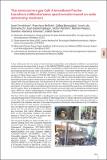Por favor, use este identificador para citar o enlazar a este item:
http://hdl.handle.net/10261/211656COMPARTIR / EXPORTAR:
 SHARE
BASE SHARE
BASE
|
|
| Visualizar otros formatos: MARC | Dublin Core | RDF | ORE | MODS | METS | DIDL | DATACITE | |

| Título: | The nanocosmos gas cell: a broadband Fourier transform millimeterwave spectrometer based on radio astronomy receivers |
Autor: | Cernicharo, José CSIC ORCID ; Beltrán, F.; Bermúdez, Celina CSIC ORCID; Doménech, José Luis CSIC ORCID ; Gallego, Juan Daniel; Herrero, Víctor J. CSIC ORCID; Peláez, Ramón J. CSIC ORCID; Ramírez, Sandra I. CSIC; Tanarro, Isabel CSIC ORCID | Fecha de publicación: | 3-sep-2018 | Citación: | 25th International Conference on High Resolution Molecular Spectroscopy (2018) | Resumen: | A Gas Cell reactor for the study of the chemical composition and evolution in different astronomical environments has been built as a part of the NANOCOSMOS project. It employs the same detection system as those present in radio-telescopes, constituting a novel and state-of-the-art approach to do rotational spectroscopy with kHz resolution. In particular, it has been implemented with Q-band (31.5-50 GHz) and W-band (72-116 GHz) receivers analogous to those built for the 40 meters telescope of Yebes Observatory (CNTRAG-IGN, Spain). These receivers are sensitive to the rotational emission of the molecules present in a one meter Gas Cell (no external polarization needed). The technique provides large instantaneous bandwidth, spectral purity, and a linear dependence of the signals with the partial pressure. Some pictures of the instrument are presented in Figure 1. The full description of the previous prototype cell can be found in I. Tanarro, et al. A&A 2018. In the initial experiments of the Gas Cell as a rotational spectrometer, we recorded the spectrum of CH3CN in the Q and W-bands. After an integration time of 11 minutes, we could observe its vibrational excited states up to ~1000 cm-1 and its isotopologues in natural abundance, including 15N with a spectral resolution of ~38 kHz and an estimated detection limit of 10-6 mbar. The Gas Cell is also equipped with a quadrupole mass spectrometer, a UV-Visible spectrometer, a cold plasma generator (inductively coupled RF discharge) and UV-lamps. All these components make of the Gas Cell a versatile instrument that allows a full characterization of gas mixtures directly introduced in the chamber and also of the reaction products formed in cold plasmas or by UV radiation of the mixtures. In the present communication, we report the results of our investigation about the UV and plasma effects on several gas mixtures that mimic different scenarios such as the interstellar medium, the stratosphere of Titan (CH4, N2), or the prebiotic terrestrial atmosphere (CH4, NH3, H2O). The research leading to these results has received funding from the European Research Council under the European Union¿s Seventh Framework Programme (FP/2007-2013)/ERC-SyG-2013 Grant Agreement No. 610256 NANOCOSMOS and from Spanish MINECO CSD2009-00038 (ASTROMOL) under the Consolider-Ingenio Program. We also thank Spanish MINECO for funding under grants AYA2012-32032, AYA2016-75066-C2-1-P, FIS2013-48087-C2-1-P, FIS2016-77726-C3-1-P, FIS2016-77578-R, MAT2014- 54231-C4-1-P and CONACYT in Mexico for grant 291842. | Descripción: | Bilbao (Spain) this September 3-7, 2018. -- http://www.hrms-bilbao2018.com/ | URI: | http://hdl.handle.net/10261/211656 |
| Aparece en las colecciones: | (CFMAC-IEM) Comunicaciones congresos (CFMAC-IFF) Comunicaciones congresos |
Ficheros en este ítem:
| Fichero | Descripción | Tamaño | Formato | |
|---|---|---|---|---|
| Nanocosmos gas cell (2).pdf | 545,12 kB | Adobe PDF |  Visualizar/Abrir |
CORE Recommender
Page view(s)
100
checked on 18-abr-2024
Download(s)
59
checked on 18-abr-2024
Google ScholarTM
Check
NOTA: Los ítems de Digital.CSIC están protegidos por copyright, con todos los derechos reservados, a menos que se indique lo contrario.
